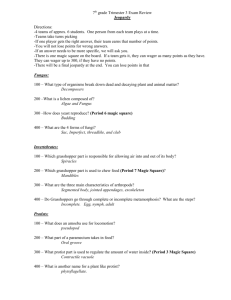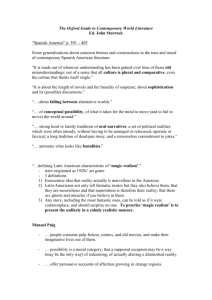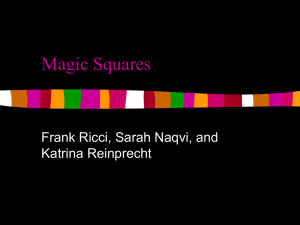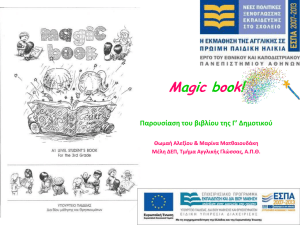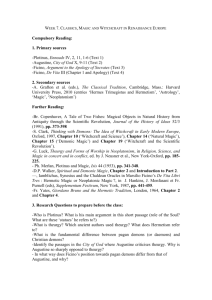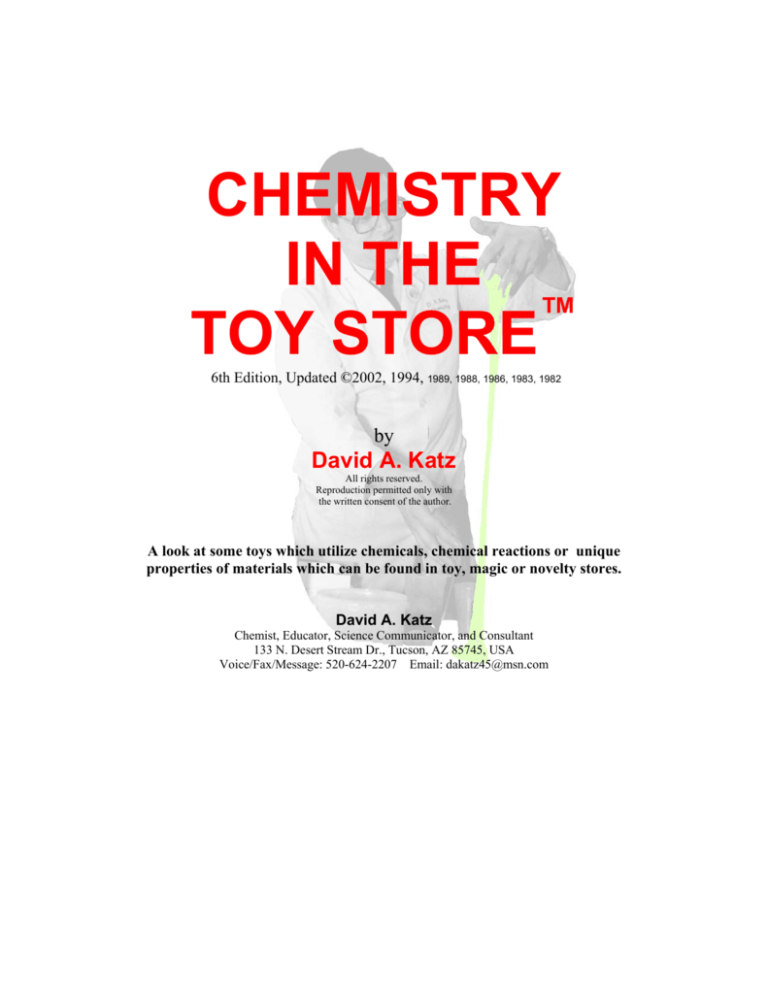
CHEMISTRY
IN THE
™
TOY STORE
6th Edition, Updated ©2002, 1994, 1989, 1988, 1986, 1983, 1982
by
David A. Katz
All rights reserved.
Reproduction permitted only with
the written consent of the author.
A look at some toys which utilize chemicals, chemical reactions or unique
properties of materials which can be found in toy, magic or novelty stores.
David A. Katz
Chemist, Educator, Science Communicator, and Consultant
133 N. Desert Stream Dr., Tucson, AZ 85745, USA
Voice/Fax/Message: 520-624-2207 Email: dakatz45@msn.com
PART III: Lightsticks, Magic Sand,
Magic Rocks, Liquid Crystals,
Dissolving Paper, Disappearing Ink,
Flammables, and Big Bang Cannons
LIGHTSTICKS
CYALUME® lightsticks, manufactured by American Cyanamid Co., with similar items available from other
manufacturers, are devices that produce a “cool-light” by means of a chemical reaction. The reaction is similar to
the one that produces light in a firefly, but the chemicals involved are different.
A lightstick consists of dilute
hydrogen peroxide solution in a
phthalic ester solvent contained
in a thin glass ampoule which is
surrounded by a solution
containing a phenyl oxalate ester
and the fluorescent dye 9,10bis(phenylethynyl)anthracene,
(blue lightsticks use 9,10diphenylanthracene)
all
contained in a plastic tubular
container.
When the glass
ampoule is broken, by bending
the lightstick, the hydrogen
peroxide and the phenyl oxalate
ester react to form phenol and
some intermediate (short lived)
compounds. During the reaction,
the energy given off is transferred to the dye molecules.
The excited dye molecules
(designated as Dye®) give off
the excess energy in the form of
light without any noticeable heat.
Thus the name, “cool-light”.
Figure 20. Summary of the lightstick reaction (from Shakhashiri, Chemical
Demonstrations, Vol. 1, Univ. Wisconsin Press, 1983)
Lightsticks can be used to demonstrate how the rate of a chemical reaction varies with temperature. To do this,
initiate three lightsticks. Place one lightstic in ice water, one in hot tap water (not boiling), and leave one at room
temperature as a control. The effect of temperature on the reaction can be observed within a few minutes.
Lightsticks are used as emergency lights and safety lights in industry and for camping. As toys, they are made in the
form of earrings, necklaces, bracelets, rings, eyeglasses, and bowties. They are also used to light up balls, golf balls,
and flying disks for nighttime playing.
A recent variation of lightsticks are Magic in the Night® light shapes. These are adhesive backed packets in various
shapes, such as circles, diamonds, and stars, and filled with lightstick chemicals which are stored in separate glass
ampoules. Both ampoules must be broken in order to mix the chemicals.
Lightsticks are dated to indicate their life time. If stored in a cool place, they remain active for at least one year past
that date. Light shapes have no expiration date.
MAGIC SAND®
Magic Sand®, also called Super Sand™ and Mystic Sand, is sand (silicon dioxide) that has been treated with a
colored dye and coated with a finely divided hydrophobic silicon coating. Due to its hydrophobic coating, Magic
Sand® can be placed in water to form underwater towers or columns and designs, and then be removed and found to
be completely dry. Because of its water repellency, the particles of Magic Sand® will stay together as a separate
phase in the water similar to the phase separation of a polar and a non-polar liquid such as vinegar and oil
The Magic Sand® is an application of an invention from Cabot Corporation, Boston, Mass, originally used for the
removal of oily contaminants from water systems. A similar material is a fumed silicon dioxide, called Cab-O-Sil,
marketed by Cabot Corp. which is used for many applications such as thickening, thixotropy, suspension of solids,
and optical clarity in products such as coatings, adhesives, cosmetics, inks, plastics, and rubbers. It is also used as
an anti-caking agent to promote the free flow of dry powders.
Magic Sand® is prepared by treating an inland sand (which has grains with rounded edges for better flow
characteristics) with an organohalosilane such as dimethyldichlorosilane, (CH3)2SiCl2. In the reaction, the surface
of the sand becomes coated with a thin monolayer silicone film, (CH3)2(OH)Si-O- which repels water because it is
similar to a hydrocarbon film. Materials such as paper, wood, glass, silk, and porcelain can also be coated with a
water-repellent film by simply exposing them to the vapor of organohalosilanes.
A Magic Sand® type of material can be made by spraying oven dried sand (one hour at 250°F) with a waterrepellent material such as Scotch-gard®.
MAGIC ROCKS®
Magic Rocks®, manufactured by Magic Rocks and Craft House Corporation, are also known as a “Chemical
Garden”. They consist of small “rocks” colored white, blue, green, red, purple, and orange or yellow. When placed
in the “growing solution”, the rocks grow forming colored columns. After growth is complete, the growing solution
can be poured off and replaced by water so that the Magic Rock garden can be maintained for decoration.
Magic Rocks® consist of a sodium silicate solution in water, Na2SiO3, (the growing solution) and small chunks of
various chemical salts. Some commonly used salts and their colors are:
calcium chloride (white), copper(II) sulfate (blue), cobalt(II) chloride (red), iron(III) chloride (yellow or
orange), nickel(II) nitrate (green), and manganese(II) chloride (pink or purple). In the past, lead(II) nitrate
was used as for white crystals.
To keep the salts stable (some of these are deliquescent or slightly efflorescent), they seem to be dispersed in an
alum or aluminum hydroxide and thus do not crumble easily. Attempting to dissolve the colored “rocks” in water or
dilute acid results in a gelatinous precipitate.
The reaction between the salt that composes the Rock and the sodium silicate results in the formation of a gelatinous
precipitate that forms a barrier between the reactants. This film then develops cracks and, since it is not firmly
adhered to the salt, allows further contact between the reactants. The mobile reactant (the salt) penetrates between
the precipitate and the support and a new layer of precipitate displaces the first. New precipitate may be formed
wherever a crack appears and the shape of the precipitate may be anything from a roughly symmetrical, cauliflowerlike growth to long, slender shoots or thin, serrated sheets.
The fact that the “rocks” are composed of highly soluble salts with a high rate of solution result in rapid growth of
precipitate. The cracks in the gelatinous layer is caused by a large difference in osmotic pressure between the
silicate growing medium and the saturated salt solution. The sodium silicate does not have a high osmotic pressure
even when concentrated because much of the silica present is in the form of aggregates (colloidal micelles or giant
ions) so that the ionic strength is quite low.
If one observes the slender shoots formed in the first stages of growth, they will see and air bubble leading the
growth upward in a jerky, side to side type of motion. This is often cited as evidence that a gelatinous membrane
bursts periodically and a new precipitate forms.
To make a chemical garden, mix 100 mL of sodium silicate solution (available from chemical supply companies and
some hobby shops) with 400 mL of water in a 600-mL beaker or glass. Add sufficient sand (silicon dioxide) to form
a thin layer on the bottom of the container and allow it to settle. Add crystals or chunks of any of the above salts to
the solution, but do not add too many at one time to prevent cloudy solutions and heavy precipitates. After the
garden is grown, it can be saved by siphoning off the sodium silicate solution and replacing it with water.
MAGIC TREE®
Magic Tree® is a miniature artificial tree that grows forming ornamental “buds” in as little as 15 minutes, and
“magically” growing into a delicate tree in about 2 hours. Magic Tree® is manufactured by New Tomorrow, Inc.
A Magic Tree® consists of two pieces of green or white colored blotter paper cut so as to be assembled into a small
evergreen tree with spots of dye on the ends of the branch tips. The tree is placed in a solution made by mixing a
small packet of blue powder with 1 teaspoon of water and, over a period of time, small crystals will grow on the
ends of the branches. After about 2 hours, the ends of the branches contain clusters of crystals. The tree can be
dried and, if protected, can last for months.
The dyes on the Magic Tree® are mainly water soluble
food colors. The growing solution is made from an
alkaline salt, ammonia, and water. A representative
solution can be made from 6 tbsp sodium chloride (this is
not an alkaline salt), 1 tbsp ammonia, 6 tbsp water, and 6
tbsp liquid laundry bluing. In operation, the solution
moves up the tree by capillary action. The tree is
permeated by the solution, however, the branch tips, being
tapered to a point, experience the most rapid rate of
evaporation resulting in crystal formation.
Laundry bluing, used to whiten fabrics which have turned
yellow or gray, is composed of a colloidal solution of
Prussian blue which is used as a blue pigment that makes
fabrics appear white. Prussian blue is made by reacting
potassium ferrocyanide with iron(III) sulfate:
Figure 21. An unassembled Magic Tree®
3 K4Fe(CN)6 + 2 Fe2(SO4)3 + x H2O → Fe4[Fe(CN)6]3 xH2O + 6 K2SO4
Note: x = 14-16
Prussian blue is formed as a precipitate (it is not soluble in water). This reaction, however, is the ideal case when
the reaction occurs very slowly. If formed quickly, as is usually the case, the Prussian blue is more likely to have
the formula K[FeIIFeIII(CN)6] xH2O. It contains iron in both the +2 and +3 oxidation states, as denoted by the
Roman numerals. The intense color is due to charge-transfer from FeII to FeIII. (There is no color if both iron
atoms are in the same oxidation state.)
Figure 22. Assembled Magic Tree® in
growing solution.
Figure 23. Magic Tree® showing
crystal growth.
Addition of ammonia, a base, and salt does not change the color of the bluing solution, but the crystals that grow are
white. It is suspected that during the evaporation of solvent and resulting crystallization there is probably a
reduction of the Prussian blue forming white K2FeIIFeII(CN)6 where additional K+ ions would fill in the crystal lattice due to the openings left by reduction of FeIII to FeII. Since there are few additional potassium ions in solution, the lattice is probably filled by the Na+ ions from the salt forming KNaFeIIFeII(CN)6) which should also
be white in color. The potassium compound, K2FeIIFeII(CN)6, is known as Everitt’s salt (first reported by Thomas
Everitt is 1835 by boiling potassium ferrocyanide with dilute sulfuric acid).
LIQUID CRYSTALS
Liquid crystals are organic compounds that are in a state between liquid and solid forms. They are viscous, jelly-like
materials that resemble liquids in certain respects (viscosity) and crystals in other properties (light scattering and
reflection). Liquid crystals must be geometrically highly anisotropic (having different optical properties in different
directions)-usually long and narrow - and revert to an isotropic liquid (same optical properties in all directions)
through thermal action (heat) or by the influence of a solvent. Liquid crystals are classified as:
smectic: molecules arranged in horizontal layers or strata and are standing
on end either vertically or at a tilt.
nematic: molecules possess a high degree of long-range order with their
long axes approximately parallel, but without the distinct
layers of the smectic crystals.
lyotropic: molecules consist of a nonpolar hydrocarbon chain with a polar
head group. In a solvent, such as water, the water molecules
are sandwiched between the polar heads of adjacent layers
while the hydrocarbon tails lie in a nonpolar environment.
If smectic and nematic liquid crystals are subjected to changes in temperature, they change their form and their light
transmission properties splitting a beam of ordinary light into two polarized components to produce the phenomenon
of double refraction. This results in the appearance of the characteristic iridescent colors of these types of liquid
crystals. This type of liquid crystal finds use in thermometers, egg timers, and other heat sensing devices. Changes
in structure can also be accomplished using a magnetic field which make them useful in calculator or other LCD
displays. Temperature sensitive liquid crystals were used in Mood Rings.
When lyotropic liquid crystals are subjected to disturbances, such as stirring or squeezing, the layers of crystals are
disturbed altering their light transmission characteristics to produce color changes similar to the smectic and nematic
liquid crystals described above. These are the type of liquid crystals used in the Press Me stickers.
Some liquid crystal products are: Mood Rings; Liquid crystal stickers, called Press Me stickers, which come in
various shapes and swirl into many different colors when gentle pressure is applied; A plastic disc called a Space
Fidgit®, made by A.R.C., contains mixture of temperature and pressure sensitive liquid crystal material which
exhibits color patterns when rubbing its back or changing its temperature; and Fickle Foam, made by Davis Liquid
Crystals, which is temperature sensitive liquid crystal sheet mounted on a thin foam pad.
Another application of liquid crystals is in Hot Wheels Color Racers® and Color FX™ cars manufactured by Mattel
Toy Corp. These are model cars that are painted with a temperature sensitive liquid crystal paint and which change
colors when placed in icy cold or warm tap water.
Other novel applications of liquid crystal materials are in Mattel’s Nickelodeon™ Color Writer™ Drawing Screen,
in dolls such as Lil Miss Magic Hair™, Hollywood Hair™ Ken , and Secret Hearts™ Barbie , and in Playskool’s
Magic Lemonade Party™ or Magic Breakfast Party™. In the Nickeloden™ Color Writer™, a heat pen, powered by
two batteries, is used to write or draw on a black liquid crystal screen. When warmed, the liquid crystals become
transparent and the colors of the board behind the liquid crystals in visible. To erase the drawing, an ice cube is
used, in a metal eraser container. In the dolls, hair or clothing is impregnated with liquid crystal material.
Depending on the doll, warming or cooling using a wand or plastic bag filled with water will cause hair color to
change, or stars or hearts to appear in hair or clothing. The Magic Lemonade or Breakfast Party, and similar toys,
use liquid crystal material to make pitchers, knives, cookies, and muffins change color to simulate pink lemonade,
orange juice, and jelly on toast or muffins. In summary, whenever a substance or object changes color with a
change in temperature, it is a high probability that liquid crystals are involved.
MELTING MONEY AND MAGIC NURSERY™ TOYS
Melting Money and Melting Memos, which were marketed by So Much Fun!, are paper items that dissolve when
placed in water. The paper is composed of carboxymethylcellulose (starch) with 20% or less cellulose (wood fibers).
This material has been used by organizations such as the CIA for secret or sensitive documents which can easily be
destroyed by wetting with water.
A number of toys using dissolving paper have appeared. Trash Bag Bunch™, from Lewis Galoob Toys, consist of
plastic figures contained in a dissolving paper garbage bag. When placed in warm water, the garbage bag dissolves
and the figure is obtained. A variation of this is Mattel’s Hot Wheels Revealers, Hot Wheels cars wrapped in a
dissolving paper cover.
A novel use of dissolving paper is the Magic Nursery™ toys. Magic Nursery™ dolls are packaged in dissolving
paper clothes and had to be placed in water to discover if the doll was a boy or a girl. There are also a number of
Magic Nursery™ accessories, one of which are Bye-Bye Diapers™. These paper diapers fit Magic Nursery and
other 10-inch to 14-inch dolls. Instead of disposing of the diapers after play, they are placed in water and dissolve to
leave a plastic package containing a pair of cloth training pants with the words “I’m in training” printed on them.
Currently, dissolving paper is available from Flinn Scientific as melting mole dollars.
SMELLY PATCHES AND SCRATCH AND SNIFF STICKERS
Smelly Patches are cloth patches backed with a heat activated adhesive that can be applied to clothing or other
objects. Smelly Patches contain a picture of a fruit such as apples, grapes, strawberries, etc..., and also smell like the
fruit that is pictured. The smell is a result of natural fragrances or esters that are microencapsulated onto the surface
of the Smelly Patch.
Microencapsulation is a process where substances such as inks or dyes, adhesives, cosmetics, pharmaceuticals, or
fragrances are contained in microscopic capsules, 20 to 150 microns in diameter, which can be broken mechanically,
electrically, or chemically to release the contents. The microcapsules are composed of different materials depending
on the substance packaged and the method by which it is to be released. Gelatin is widely used as an encapsulating
agent. The advantage of microencapsulation is that the capsules remain stable and inert until broken down. A major
producer of microencapsulated materials is the 3M Corporation.
A similar product to the Smelly Patches are scratch and sniff spots which are often used in magazine or direct mail
advertisements or children’s books. There are also scratch and sniff stickers. In both cases, an individual usually
uses a fingernail to mechanically break the microcapsules releasing the contents.
Flavors and fragrances may utilize a single ester or a mixture of esters and other substances. Some esters that smell
like common materials that can be prepared in the laboratory are listed in Table 1.
Table 1. Common esters used for flavors and fragrances
–––––––––––––––––––––––––––––––––––––––––––––––––––––––––––––––––––
Ester
Smells like
Prepared from
–––––––––––––––––––––––––––––––––––––––––––––––––––––––––––––––––––
isoamyl acetate
banana
isoamyl alcohol and acetic acid
ethyl butyrate
pineapple
ethanol and butanoic acid
benzyl acetate
peaches
benzyl alcohol and acetic acid
n-propyl acetate
pears
n-propyl alcohol and acetic acid
benzyl butyrate
flowers
benzyl alcohol and butanoic acid
methyl butyrate
apples
methanol and butanoic acid
isobutyl propionate
rum
isobutyl alcohol and propionic acid
octyl acetate
oranges
octanol and acetic acid
methyl anthranilate grapes
methanol and 2-aminobenzoic acid
––––––––––––––––––––––––––––––––––––––––––––––––––––––––––––––––––––
Esters can be made, in the laboratory, by mixing a few mL each of an alcohol and an organic acid and adding a few
drops of concentrated sulfuric acid or phosphoric acid. The acid should generate sufficient heat to initiate the
reaction, but the mixture can be heated in a water bath if necessary. If the esters are intended to be passed around a
group of people, add a small amount of glass wool to the container to prevent spilling or splashing.
NITINOL: THERMOBILES AND BUTTERFLIES
Nitinol is a nickel-titanium alloy that was first made at the U.S. Naval Ordnance Laboratory. This alloy exhibits a
shape memory effect, that is, it radically changes shape when subjected to a temperature change. Nitinol wire is soft
at a low temperature and can easily be bent into simple shapes. At high temperature. the Nitinol wire becomes stiff
reverting to its original shape.
One application of Nitinol is the Thermobile (see Figure 24), a device consisting of a wire loop around two pulleys,
one brass and one plastic, that generates power without a motor or batteries. The Thermobile is manufactured by
Innovative Technology International, Inc.
The Thermobile works by immersing the bottom
edge of the brass pulley into hot water between 50°C
and 75°C. Within a few seconds, the Thermobile
will begin to spin continuing as long as the bottom is
at a temperature above 50°C. What takes place is
that the Nitinol wire, bent around the metal pulley,
will try to straighten itself out and, in the process,
will cause the wheel to spin. The effect can also be
produced by using solar energy, with the aid of a
magnifying glass, to heat the brass pulley.
Figure 24. A Thermobile
An improved version of Nitinol wire, consisting of approximately 50% each of nickel and titanium is manufactured
by Toki Corporation under the name BioMetal®. This alloy has been stretched and, when heated, will shorten to its
original shape. BioMetal® wire is used in a device called Space Wings and a Kinetic Butterfly, butterfly types of
devices which flaps their wings due to the contraction of the BioMetal® wire.
DISAPPEARING INK
Disappearing ink is a bright blue water-based solution which, when squirted on clothing, table cloths, or other
materials, will disappear within minutes leaving only a colorless “water spot” that will evaporate slowly. When dry,
there is a small amount of white residue that remains.
The pH of the disappearing ink solution is about 10-11 (moderate to strong base). Addition of acid, such as
hydrochloric acid, HCl, causes the solution to turn colorless forming a white precipitate. Addition of base, such as
sodium hydroxide, NaOH, dissolves the precipitate and restores the blue color. If the “ink” is squirted on cloth, the
colorless water spot that remains after the color fades is slightly acidic with a pH of about 5-6. Addition of base to
the water spot causes the blue color to return. The blue color is also obtained if base is placed on the dried “ink”
spot.
Due to its color change with pH, the material used to make the disappearing ink was identified as an acid-base
indicator called thymolphthalein, C28H30O4 (colorless to blue at pH 9.3-10.5). This was confirmed by infrared
spectrophotographic analysis by the author.
The disappearing ink is made by dissolving a small amount of thymolphthalein in ethyl alcohol followed by dilution
with water. The blue color is obtained by the addition of a small quantity of sodium hydroxide solution. A red
disappearing ink can be made using phenolphthalein in place of the thymolphthalein.
The pH change which causes the color to fade is a result of the reaction of the sodium hydroxide, NaOH, with
carbon dioxide, CO2, in the air to form sodium carbonate, Na2CO3, according to the following reaction:
2 NaOH + CO2 → Na2CO3 + H2O
Once the sodium hydroxide is neutralized, the acidity of the alcohol changes the “ink” to colorless.
Disappearing ink, both blue and red, are used as the fuel in Zap-it® guns. These are battery powered water pistols
used to shoot the colored liquid which acts as an indicator to show a victim is “shot”.
A novel application of the disappearing ink reaction is Mattel’s Hollywood Hair™ Barbie dolls. The extra long
hair of the doll is coated with phenolphthalein indicator. When sprayed with Magic Hair Mist, consisting of ethyl
alcohol, water, and a base, such as sodium hydroxide, the hair of the doll turns pink. As the hair dries the pink color
fades to colorless.
MYSTIC SMOKE
Mystic Smoke is a grease-like paste that produces puffs of “smoke” from the fingertips when they are squeezed
together and then snapped apart. It is used by magicians or jokesters to pinch some smoke from a cigarette (either
lighted or unlit) and throw it away, or to pull out “cobwebs” from an old book or their wallet.
Mystic Smoke is a grease-like paste made from a mixture of machine oil, linseed oil, scale wax, carnauba wax, soap,
latex, resins, and rosin. In use, a small amount is rubbed onto the thumb and first finger of a warm hand until it is
undetectable. The fingers are squeezed together, allowing the Mystic Smoke material to adhere to itself, and then
snapped apart producing spider web-type strings that give the appearance of smoke
Several types of heavy greases and petroleum jelly (Vaseline) were tried by the author in an attempt to duplicate the
Mystic Smoke effect without success.
SPARKLERS
Sparklers in gold, red, green, and blue colors are often used to decorate birthday cakes or similar items for parties, or
for celebrating holidays. Sparklers consist of a metal wire with about 3/4 of it covered with a silver or colored hard
material. The combustible material is most commonly a gunpowder type material consisting of sodium and/or
potassium nitrates (chlorates may be used) with sulfur and carbon. The sparks are provided by powdered metals
such as iron, aluminum, or magnesium. The metal powder is coated with paraffin wax to prevent oxidation during
storage and to allow the metal to fall off the sparkler as it burns producing the characteristic sparks. Colors are
produced by adding nitrate or chloride salts of strontium (red), barium (green) and copper (blue). The combination
of added metal salts and paraffin wax are responsible for making the sparkler difficult to ignite. When using
sparklers, take care to keep them away from the face and body, as well as away from any flammable material. After
combustion is complete, the wire will be hot.
FLASH PAPER
Flash Paper is available in magicians’ supply store and novelty shops. It can be purchased in pads of 20 2{ in. x 3 in.
sheets (6.3 cm x 7.6 cm) and in 8 in. x 10 in. sheets (20 cm x 25 cm). It is also available in the form of Flash Bills,
which approximate the size and color of a U.S. one dollar bill, and Flash Cotton.
Flash paper is commonly use by magicians to throw fire into the air or with magic wands that shoot bursts of flame.
Flash paper burns leaving almost no ash.
Flash paper is nitrocellulose, sometimes called guncotton (approx. formula C6H7O2(ONO2)3). It is prepared by
treating cellulose, in the form of paper or cotton, with a mixture of nitric and sulfuric acids. There are many different forms of nitrocellulose obtained by varying the strength of acids used, temperature and time of reaction,
and the acid/cellulose ratio. Other uses of nitrocellulose are in fast drying automobile lacquers, collodion, rocket
propellant, medicine, printing ink base, coating bookbinding cloth, and leather finishing. Nitrocellulose, as used in
flash paper, is extremely flammable and some forms can explode on sharp impact.
FLASH POWDER
Flash powder can be obtained at magicians’ supply stores in two different forms. One type is a pre-mixed powder,
and the second type is a photographic flash powder that comes packaged in two separate containers. In practice,
flash powder is used in the theater for special effects, usually with a special flash pot, when making persons or
things disappear.
The pre-mixed flash powder was analyzed by the author and found to be mainly a gunpowder or black powder
consisting of sodium and potassium chlorates and/or nitrates with sulfur and carbon.
The two component photographic flash powder it the type that was often used before the invention of flash bulbs.
Its use can sometimes be observed in some silent movies and early talking movies. The two components were analyzed and the one component was found to be a mixture of powdered magnesium and powdered aluminum, with
potassium chlorate as the second component.
Flash powders, when mixed, are extremely flammable and shock sensitive and, if covered or placed in a closed
container, are explosive. Mix only in plastic containers with plastic utensils and with great caution. Mix only as
much as you plan to use and never store mixed flash powder. Once mixed the material is unpredictable and should
be used immediately.
DRAGON’S BREATH
Dragon’s Breath is available from magicians’ supply stores. When sprayed into a fire, it burns producing a large
billow of flame like a dragon’s breath. This is the material a magician uses to produce a puff of flame from his/her
hand.
Dragon’s breath is composed of lycopodium, a fine yellowish powder which is composed of club-moss spores
(available from many laboratory supply houses). The process of spraying it into a fire results in a dust explosion as
the fine particles burn when heated in an abundance of fresh air. It can be demonstrated that lycopodium does not
burn in bulk by attempting to burn a small pile of it on a ceramic or other flame proof board. Lycopodium can be
sprayed from a plastic wash bottle, a small rubber bulb, or simply thrown into a flame.
Care should be exercised in using lycopodium powder as some individuals are allergic to the spores.
SNAKES
Magic Snakes, sometimes called Pharaoh’s Serpents, come as small pellets which, when ignited, “grow” into long
curving columns of ash resembling a “snake”. Originally, snakes were composed of mercury(II) thiocyanate,
Hg(CNS)2, which was bound into a pellet by using dextrin or a gum. Due to the toxic nature of the mercury(II)
thiocyanate and of the combustion products, sulfur dioxide and mercury vapors, the mercury compound has been
replaced. The black, non-mercury snakes now available are composed of a naphthol pitch that has been mixed with
linseed oil, treated with nitric acid, washed and air dried, then broken up and further treated with picric acid. The
product is then mixed with gum arabic, pelleted, dried, and aged for several months.
CAPS AND BLASTER BALLS
Caps used in cap guns usually contain 0.20 grains or less of a pyrotechnical material composed of potassium
chlorate, KClO3; red phosphorus, P4; manganese dioxide, MnO2; magnesium oxide, MgO or calcium carbonate,
CaCO3; sand, SiO2; and glue to bind it together. The manganese dioxide catalyzes the decomposition of potassium
chlorate to form oxygen and potassium chloride. The magnesium oxide or calcium carbonate acts as an anti-acid to
prevent deterioration due to moisture in storage. The sand helps to produce friction. The mixture of potassium
chlorate and phosphorus is explosive and extremely unpredictable in any quantity.
A variation of the caps used in cap guns are called Blaster Balls marketed by Placo Products Co., Cosmos®, and
others. These consist of a set of two ceramic balls of different colors (usually yellow and black, or red and blue),
which are both coated with a thin layer of the same chemical mixture of potassium chlorate, sulfur, glue, and powdered glass (silica). To use Blaster Balls, holding one ball in the hand, toss the other ball into the air and catch it
by bringing the hand with the ball upward cracking the balls together. When the coated surfaces of the two balls hit
together, there is a cap-like blast produced. The same cap-like blast can be produced if a single ball hits a high
silica-containing substance, such as concrete, indicating that the silica produces sufficient friction, and heat, to
detonate the chemical mixture. A pair of Blaster Balls can produce over 200 blasts. (NOTE: Although Blaster Balls
are non-flammable, a mixture of potassium chlorate and sulfur is explosive and is unpredictable in any quantity.)
SNAP’N POPS
Snap’n Pops, also called Devil Bangs, Rio Snappers, or Bang Snaps are noisemakers made in Brazil or Korea. A
Snap’n Pop is a cigarette paper rolled and twisted into the shape of a roughly spherical teardrop with a tail. The
teardrop is loaded with about 0.18 gram of small gravel or coarse sand coated with 0.0008 gram of silver fulminate,
Ag2(CNO)2. When the device is thrown against a hard surface, friction between the granules sets off the silver fulminate with a quick bang.
The explosion generates little flame and almost no gas, as compared with toy caps, so that the granules are not
widely scattered. Except for the paper wrap, they are nonflammable. They are safe in storage and shipment. They
are not set off by heating to 75°C (167°F) but will detonate if exposed to a flame. Even when detonated in the hand,
it causes no burn, tingle, or damage.
BIG-BANG® CANNONS
Figure 25. A Big-Bang® Cannon
A Big-Bang® Cannon (see Figure 25), made by The Conestoga Company, Bethlehem, Pa., is fueled by a substance
called Bangsite®. Bangsite® is powdered calcium carbide. The Bangsite® is placed in a breech block on the
cannon and a small amount is emptied into the firing chamber which contains a small amount of water. On reaction
with water, acetylene is produced:
CaC2 + H2O → CaO + C2H2
calcium
calcium
acetylene
carbide
oxide
The acetylene produced mixes with the oxygen in the air within the firing chamber. When a spark is produced by the
firing mechanism, the acetylene gas burns rapidly to produce carbon dioxide and water vapor according to the
reaction:
2 C2H2 + 5 O2 → 4 CO2 + 2 H2O
This rapid burning produces heat resulting in the almost instantaneous expansion of the gases forcing them out of
the muzzle of the cannon. The combustion of the remaining gases is completed outside of the cannon leaving a -
partial vacuum outside the muzzle and within the cannon. The resulting “inrush” of the atmosphere to fill the void is
perceived as an explosion producing a loud bang or noise. (see Figure 26)
Figure 26. Firing the cannon



